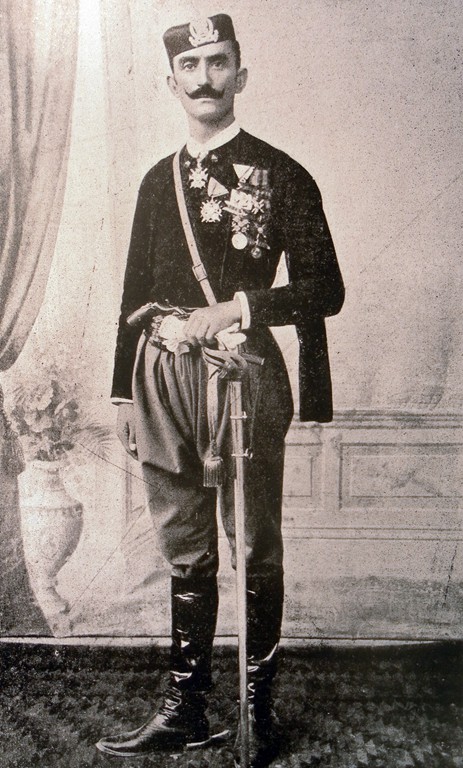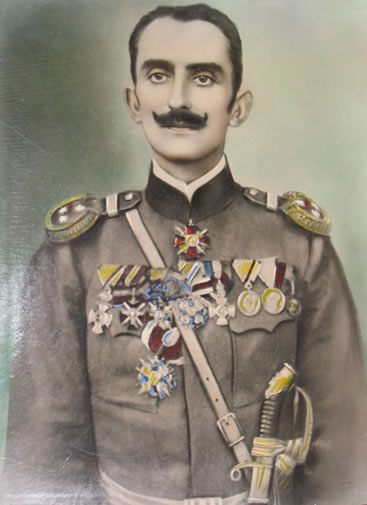Aleksandar Lekso Saičić, a Montenegrin and Russian officer renowned for his valor during the Russo-Japanese War of 1904-1905, is at the center of a fascinating historical debate. Among the myriad tales of bravery and strategy from this conflict, one story stands out: the purported duel between Saičić and a Samurai, a Japanese officer. This tale, embroidered with the threads of heroism and cultural clash, has sparked a division among historians and enthusiasts alike.
While numerous sources in Montenegrin and Serbian media, as well as entries on Wikipedia, present this duel as an unquestionable fact, often romanticizing the event, there is a counter-narrative. Forums like the esteemed Historum.com cast a skeptical eye on these claims, suggesting that they may be nothing more than imaginative fabrications rather than historical truth. In our upcoming article, we delve into the layers of this intriguing story, attempting to discern myth from reality in the fog of war and folklore.
According to legend
The majority of the text that you will find in the next chapter is taken from the work of historians Dr. Đuro Batrićević and Petar Milatović
“Two armies rolled towards each other. And then they encamped under Jun-ju-an in eastern Manchuria, not so far from Vladivostok. Russians against the Japanese, in the second year of the Russo-Japanese War (1904–1905). According to classic scenography, the battle was to be initiated in the middle of a field. A wide one, of course. And while the Russian strategists were still searching for the best path to victory after a series of failures, a horseman with a white flag emerged from the opposite camp. What does this one want now?
The commander of the Japanese units, through his envoy with a white flag, demanded that his Russian counterpart select a warrior who would, before the battle, engage in a duel with their samurai. The Russian staff officers were, to put it mildly, astonished. The high-ranking officers with epaulettes couldn’t believe that the Japanese, even at the beginning of the 20th century, were adhering to their ancient custom. The deliberation lasted long: if they didn’t send a duelist, it would be a disgrace, but if they decided to accept the Japanese challenge, whom to send to confront their skilled and experienced warrior. They knew that victory in such a duel would mean a significant psychological advantage before the upcoming battle.
And the decision was made: to find a volunteer who would be willing and dare to confront the samurai. They found him immediately, or rather, he found them. As soon as the word spread around the camp that a voluntary prisoner was sought to defend the honor and glory of Russian arms and martial skills, a tall and slender lieutenant almost ran to the commander’s tent.
Aleksandar Saicic from Berane, Montenegro – he saluted sharply. – A subject of Prince Nikola, now in the service of His Imperial Majesty, I am ready to confront the despised enemy.
While the staff officers skeptically sized up the thirty-two-year-old volunteer, he stood before them as if rooted to the spot, patiently waiting for further orders. The high-ranking officers whispered amongst themselves for a long time and then decided that they had no choice but to give him a chance since he had asked so confidently and no one else had volunteered yet.

The cadet of Prince Nikola properly saluted and immediately set out in search of a horse and a saber that would suit him best. He quickly found a saber, and from the offered horses, he chose the third one. The one that, on the rider’s command, could move left then right, and timely avoid the enemy’s attack. In an unreal environment, like the one from our epic poems, Saičić rode out into the middle of the field, accompanied by the music of a military march. From the opposite camp, the story goes, a warrior dressed in black fur emerged. A godly fear. Lexo later said that he reminded him of some ominous black eagle. A duel to the death.
The voices of the armies quieted down when the champions started moving towards each other. The earth crackled under the hooves of the horses. Then the echo after the clash of steel on steel. Both still in the saddle. Then another charge. Hero aimed at hero. The poet saw it like this: “One flew at the other / Like eagles they clashed / And the sabers twirled / Reflecting off the Sun…” Like some ancient chorus, the sighs of the army, now from one side, now from the other.
Then Saičić felt intense pain and something warm started running from his forehead into his eyes. With the sleeve of his uniform, he managed to wipe the blood for a moment and see the ominous blade just above his head. In an instant, he ducked and swung his saber. He heard a roar beside his ear, then a thunderous “hurrah” in Russian. The terrible neighing made him turn around: the samurai’s horse was frantically fleeing, dragging its master with legs stuck in the stirrup. He fell out about a hundred meters in front of the first rows of the Japanese army.
Saičić rode up to the motionless body, bowed, and galloped back towards his own. He was greeted with music and the command “at ease”. Then, they say, thunderous applause spread through the Russian army. Among the first to congratulate him was Admiral Rozhestvensky of the Russian fleet, one of their most capable commanders at the time, and soon, with special escort, arrived Admiral Togo of the Japanese fleet, who easily bowed to the victor. Chivalry was still highly valued then.”
Unraveling History: Analyzing Inconsistencies in the Narrative
To analyze the historical inconsistencies mentioned in the text, let’s consider each point:
Saicic’s Duel with a Samurai: Samurai were a warrior class in Japan, existing until the late 19th century. The Meiji Restoration, which occurred in 1868, marked the end of the samurai era. By the time of the Russo-Japanese War (1904-1905), the samurai class had been abolished, and Japan had modernized its military forces. Therefore, it would be historically inaccurate for Saicic to have dueled with a traditional samurai. If a duel did occur, it would more likely have been with a modern Japanese officer.
Samurai Attire: The claim that the Samurai was dressed in 16th or 17th-century armor during this period is anachronistic. By the early 20th century, the Japanese military had adopted uniforms more akin to those of Western armies, influenced notably by Prussian military dress. Traditional samurai armor would have been obsolete and impractical in this context.
Location of the Battle: The text’s vagueness about the exact location of the battle raises questions. Historical records of the Russo-Japanese War provide detailed accounts of major battles, yet there seems to be no mention of this specific engagement, suggesting it might be a fictional or embellished account.
Presence of Admirals Zinovy Petrovich Rozhestvensky and Tōgō Heihachirō: Both were naval officers – Rozhestvensky in the Russian Navy and Tōgō in the Imperial Japanese Navy. Their presence in a land battle is highly unlikely, as their primary roles and expertise were in naval warfare.
Historical records firmly establish that Zinovy Petrovich Rozhestvensky, commander of the Russian Baltic Fleet, was occupied with naval engagements during the Russo-Japanese War, notably the Battle of Tsushima in May 1905, where he was captured by the Japanese. This context makes his supposed involvement in any land-based duel or event during this period highly unlikely. Rozhestvensky’s naval responsibilities and subsequent capture at Tsushima starkly contradict claims of his presence at any such terrestrial encounters, further highlighting the narrative’s historical inaccuracies.
The accumulation of these historical inaccuracies and anachronisms leads many to believe that the entire event might be a product of imagination rather than a factual account.
Between Legend and Reality: The Story of Aleksandar Lekso Saicic
In the intricate weave of history and legend, the tale of Aleksandar Lekso Saicic occupies a fascinating middle ground. Undoubtedly a historical figure, Saicic’s journey from a voluntary recruit in the Russian Imperial Army to a celebrated hero in Montenegro is a narrative rich in valor and intrigue. His bravery in the Russo-Japanese War earned him notable Russian decorations: the Order of Saint Vladimir, 4th class with swords and bow; the Order of Saint Anne, 2nd and 3rd classes; and the Order of Saint Stanislaus, 2nd and 3rd classes with swords and bow.

Back in Montenegro, Saicic was hailed as a hero, revered by both the populace and the royal family. Family lore holds the tale of a duel with a Japanese soldier, during which Saicic was wounded in the head. This specific event, blurred with time, remains a blend of fact and folklore. However, it’s plausible that Saicic indeed bested a Japanese officer, either in a duel or a battle, earning his heroic status.
Over decades, Saicic’s story has been embellished by oral tradition, transforming him into a figure of legend. While the core of his history as a courageous soldier who received commendations is undeniable, the layers of myth that have built up around him illustrate how history often morphs into legend, capturing the imagination and spirit of the times.
Historical Challenge: Can You Conquer the Past?
Answer more than 18 questions correctly, and you will win a copy of History Chronicles Magazine Vol 1! Take our interactive history quiz now and put your knowledge to the test!

